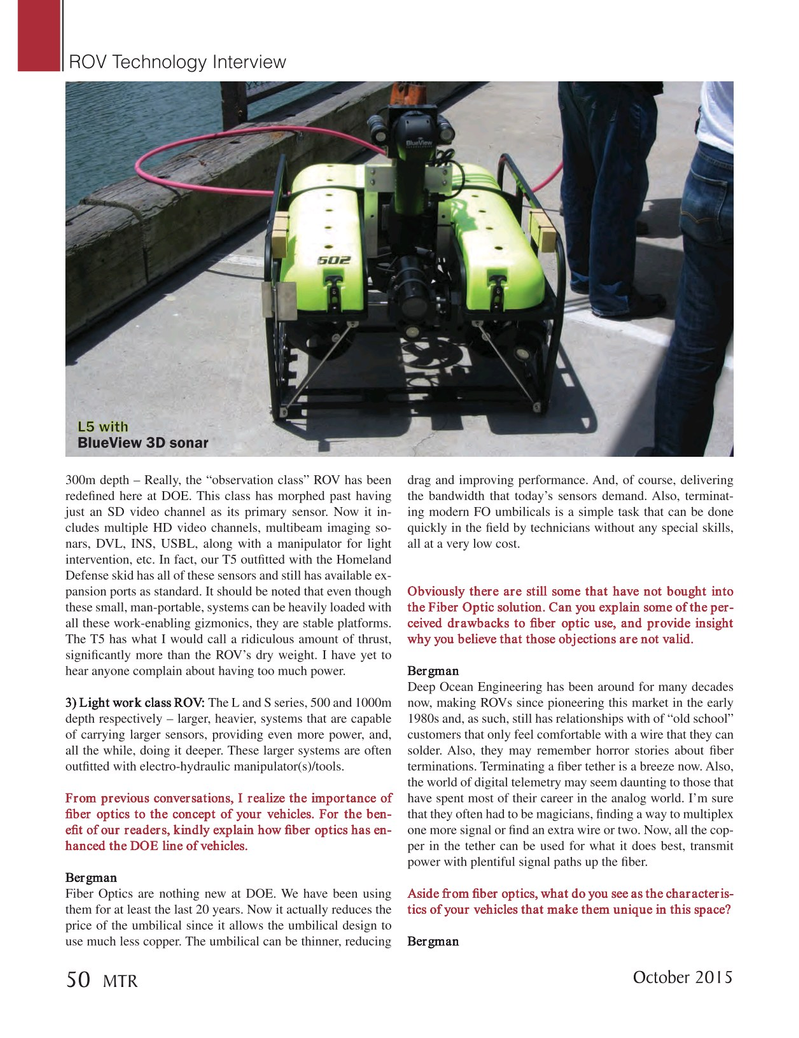
Page 50: of Marine Technology Magazine (October 2015)
AUV Operations
Read this page in Pdf, Flash or Html5 edition of October 2015 Marine Technology Magazine
ROV Technology Interview
L5 with
BlueView 3D sonar 300m depth – Really, the “observation class” ROV has been drag and improving performance. And, of course, delivering rede? ned here at DOE. This class has morphed past having the bandwidth that today’s sensors demand. Also, terminat- just an SD video channel as its primary sensor. Now it in- ing modern FO umbilicals is a simple task that can be done cludes multiple HD video channels, multibeam imaging so- quickly in the ? eld by technicians without any special skills, nars, DVL, INS, USBL, along with a manipulator for light all at a very low cost.
intervention, etc. In fact, our T5 out? tted with the Homeland
Defense skid has all of these sensors and still has available ex- pansion ports as standard. It should be noted that even though Obviously there are still some that have not bought into these small, man-portable, systems can be heavily loaded with the Fiber Optic solution. Can you explain some of the per- all these work-enabling gizmonics, they are stable platforms. ceived drawbacks to ? ber optic use, and provide insight
The T5 has what I would call a ridiculous amount of thrust, why you believe that those objections are not valid. signi? cantly more than the ROV’s dry weight. I have yet to hear anyone complain about having too much power. Bergman Deep Ocean Engineering has been around for many decades 3) Light work class ROV: The L and S series, 500 and 1000m now, making ROVs since pioneering this market in the early depth respectively – larger, heavier, systems that are capable 1980s and, as such, still has relationships with of “old school” of carrying larger sensors, providing even more power, and, customers that only feel comfortable with a wire that they can all the while, doing it deeper. These larger systems are often solder. Also, they may remember horror stories about ? ber out? tted with electro-hydraulic manipulator(s)/tools. terminations. Terminating a ? ber tether is a breeze now. Also, the world of digital telemetry may seem daunting to those that
From previous conversations, I realize the importance of have spent most of their career in the analog world. I’m sure ? ber optics to the concept of your vehicles. For the ben- that they often had to be magicians, ? nding a way to multiplex e? t of our readers, kindly explain how ? ber optics has en- one more signal or ? nd an extra wire or two. Now, all the cop- hanced the DOE line of vehicles. per in the tether can be used for what it does best, transmit power with plentiful signal paths up the ? ber.
Bergman
Fiber Optics are nothing new at DOE. We have been using Aside from ? ber optics, what do you see as the characteris- them for at least the last 20 years. Now it actually reduces the tics of your vehicles that make them unique in this space? price of the umbilical since it allows the umbilical design to use much less copper. The umbilical can be thinner, reducing Bergman
October 2015 50
MTR
MTR #8 (50-64).indd 50 9/29/2015 3:21:25 PM

 49
49

 51
51
